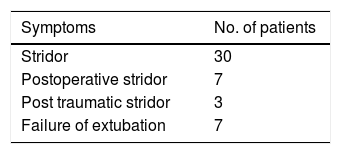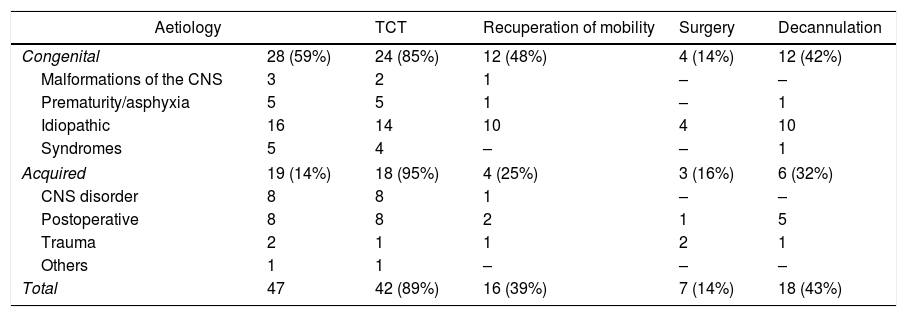Bilateral vocal cord paralysis (BVCP) is the second most common cause of neonatal stridor. The aim of this study was to describe the demographic features, aetiology, comorbidities, and management of our patients with BVCP.
Material and methodsWe conducted a retrospective review of the clinical charts of all patients diagnosed with BVCP seen at the Department of Respiratory Endoscopy between 2011 and 2015.
Results47 patients were included. Mean age at diagnosis was 1 month and male sex predominated (63%). The aetiology was congenital in 59% and acquired in 41% of the infants. The cause was most frequently idiopathic in the former group and secondary to postoperative injury in the latter. Overall, 42 patients (89%) required tracheostomy, without statistically significant differences between the causes. Of all the patients, 39% regained vocal-cord mobility; 44% of those with congenital BVCP, 31% of those with acquired BVCP and 62.5% with idiopathic BVCP. In five patients a laryngotracheoplasty was performed with a posterior costal cartilage graft and one underwent posterior cordectomy. All were decannulated. In one patient vocal-cord lateralisation was performed, avoiding tracheostomy.
ConclusionBVCP was most commonly of congenital cause and was mainly idiopathic within this group of patients, with a slight male preponderance. A high percentage of patients required tracheostomy. A higher recovery rate of vocal-cord mobility was observed in idiopathic BVCP, which allowed for successful decannulation. In this series, decannulation was possible in all patients that underwent surgery; however, further studies with comparison of techniques and objective assessment of swallowing and phonation are necessary.
La parálisis bilateral de cuerdas vocales (PBCV) es la segunda causa más frecuente de estridor neonatal. Nuestro objetivo es describir la demografía, etiología, comorbilidades y tratamientos instaurados.
Materiales y métodosRevisión retrospectiva de las historias clínicas de pacientes con diagnóstico de PBCV de 2011 a 2015.
ResultadosSe incluyeron 47 pacientes. La edad media de diagnóstico fue un mes de vida, con predominio de sexo masculino (63%). El 59% fue por causa congénita y el 41% adquirida, por lo general idiopática y postoperatoria, respectivamente. Se realizó traqueostomía (TQT) en 42 pacientes (89%), sin diferencias significativas en relación con la causa. La recuperación de la movilidad cordal fue del 39% en toda la muestra, 44% en la congénita, 31% en la adquirida y 62,5% en la idiopática. A 5 pacientes se les realizó laringotraqueoplastia con injerto costal posterior y a un paciente cordectomía posterior. Todos fueron decanulados. A un paciente se le realizó lateralización cordal, evitando la TQT.
ConclusiónLas causas congénitas fueron las más frecuentes, en su mayoría idiopáticas. Se registró una leve predilección por el sexo masculino. Un alto porcentaje de pacientes requirieron de TQT. La tasa de recuperación de la movilidad es mayor en causas idiopáticas. Se decanularon todos los pacientes operados, pero se requieren trabajos con mayor número de participantes, comparación de técnicas y evaluación de la deglución y la fonación de forma objetiva.











